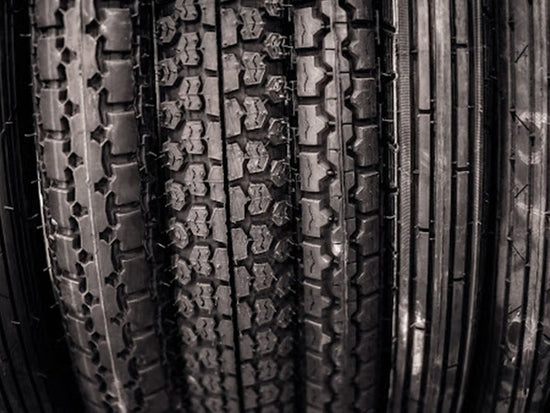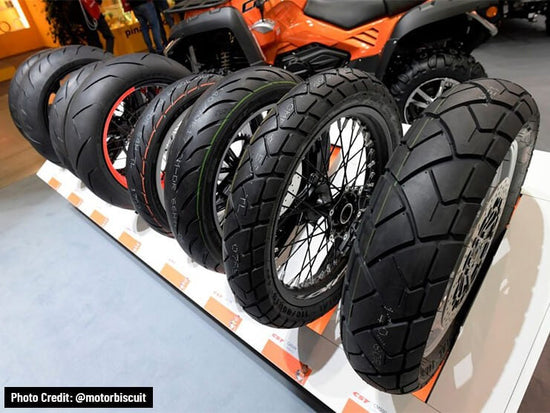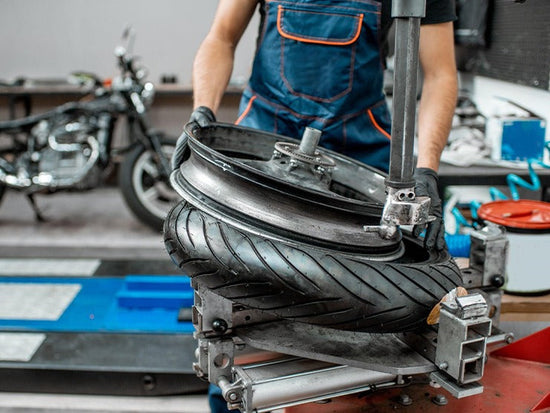Table of Content
Automobile tires carry heavy loads and are even exposed to harsh conditions on the road. However, motorcycle tires wear out much faster than other automobile tires. Although automobile tires may look the same, they come with unique builds for each vehicle type. Both motorcycles and cars have engines that deliver power to the wheels, ensuring the tires rotate at a steady rate in the right direction. Most motorcycles have one power/drive wheel (rear wheel), while only a few motorcycles have a two-wheel drive (2WD) system. Meanwhile, most cars have a two-wheel drive system, while only a few cars have a four-wheel drive (4WD). The fewer power/drive wheels contribute to the early wear and tear of motorcycle tires. Read this article to learn why motorcycle tires wear out faster than car tires.
Also Read: CHOOSING THE RIGHT TIRES FOR YOUR MOTORCYCLE
1. Why Do Motorcycle Tires Wear Out Faster Than Car Tires?
1.1 Different Purposes
Motorcycles and cars are designed to travel in different conditions. Motorcycles are smaller and more lightweight than cars, making them highly maneuverable. They can maneuver better on flat surfaces, absorb the shock of hitting potholes, and ride on bumpy roads safely without suffering serious damage. Meanwhile, most modern cars have low ground clearance and can become damaged while driving on bumpy roads.
Adventure bikes, dual sport bikes, scramblers, and dirt bikes are designed to maneuver on dirt, gravel, sand, mud, and rocky terrain. Certain cruisers and touring bikes can also handle traveling on harsh road conditions to some extent. Though they are capable of off-roading, their tires are prone to wearing out faster over time.
1.2 Tire Material/Compounds
Motorcycle and car tires are constructed with different chemical compositions. Motorcycles balance on two wheels, with the surface area of the contact patch against the road changing while turning. Motorcycle tires are not as flat as car tires because they have to maintain their grip at an angle during turns. Motorcycle tires are made of softer material that contours around the road’s surface to ensure better traction. Due to being made of softer compounds, motorcycle tires wear out faster than car tires.
1.3 Number of Power/Drive Wheels
A motorcycle and car power/drive wheel is built to endure more pressure and resistance than a non-drive wheel. A power/drive wheel also wears out faster than a non-drive wheel. Most motorcycles are driven by the rear wheel, resulting in most of the weight and pressure being put on the rear wheel. The rear wheel is forced to endure the full weight alone resulting in it wearing out faster. Meanwhile, cars have two- or four-wheel drives which equally distribute the weight among all the tires, resulting in less wear and ensuring better longevity.
1.4 Narrower Contact Patch
Motorcycle tires are usually narrower than car tires. They have a U-shaped surface that keeps them in contact with the tarmac while leaning or cornering. Due to their narrow design, the surface area touching the tarmac is smaller than car tires. More pressure is put on the smaller/narrower tire treads causing them to wear out faster than car tires.
1.5 Impact of Leaning
To turn a corner, a motorcycle has to lean in the direction of the turn while rotating the handlebars. When leaning on a motorcycle, the contact patch will shift as the motorcycle tires lean at an angle. Meanwhile, turning with a car does not require any leaning, only rotating the steering wheel in the direction of the turn. Due to the constant shifting of the contact patch against the road, the tire treads are rubbed constantly until the tire walls become weakened.
1.6 More Rotation Cycles
Tire circumference also affects how quickly tires become worn out. Motorcycle tires have a smaller circumference than car tires. A smaller circumference means that motorcycle tires undergo more rotation cycles per mile than car tires, resulting in more use and early wear and tear.
2. How Can You Make Your Motorcycle Tires Last Longer?
2.1 Proper Maintenance
You can improve the lifespan of your motorcycle tires by keeping them maintained during regular inspections. Never ride your motorcycle if it has under or over-inflated tires. Make sure to check the tire pressure before going for a ride.
2.2 Improve Your Riding Skills and Habits
If you are a rash rider who often hits potholes and debris on the road, you must work on your riding skills to improve the lifespan of your motorcycle tires. Even if you own an adventure or dirt bike, there is a safe way to ride on dirt trails to avoid damaging the tires and suspensions. Riding slowly can help you evaluate the conditions of the road and make timely decisions to avoid obstacles.
2.3 Choose the Right Motorcycle
Different types of motorcycles are built for specific purposes. Sports bikes are designed for aggressive riding and track racing, adventure bikes are designed for on- and off-roading, dirt bikes are suited for dirt and off-road trails, and cruisers and touring bikes are designed for comfortable long-distance rides. The tires for each motorcycle type are designed to better handle the conditions of the terrain these vehicles are best suited for. For example, if you ride a sports bike, make sure to stay on paved roads. You should also choose a motorcycle according to your skill level. If you are a beginner, it is better and safer to ride an entry-level motorcycle.
2.4 Use Good-Quality Tires
Make sure to use good-quality tires that last longer and improve your motorcycle’s safety and performance. The tires you use must be compatible with your specific make and model.
3. Frequently Asked Questions (FAQs)
3.1 How Many Miles Do Most Motorcycle Tires Last?
Different types of motorcycles require different tires. Some motorcycle tires last only 1,500-2,000 miles, while others can last longer between 8,000-10,000 miles. Factors that can affect tire lifespan include the motorcycle’s purpose, such as being suited for on- or off-roading. However, an average motorcycle tire can last between 4,000-8,000 miles if properly maintained.
3.2 When Should You Change Your Motorcycle Tires?
Listed below are signs that you need to change your motorcycle tires:
- If cracks start to appear on worn-out motorcycle tires.
- Deformation in the shape of the tire indicates that it has passed its service life
- The contact patch becomes flat
- The oil coating the tires dries out and causes them to harden.
Motorcycle tires must be replaced every five years. There is a four-digit code on the side of the tire wall which tells its manufacturing date.
Also Read: WHY DO MOTORCYCLES PULL TO ONE SIDE?
3.3 Why Do Motorcycle Tires Have Less Treads?
Tire treads are designed to displace water between the tire and the road surface to reduce the risk of hydroplaning. Motorcycle tires have fewer treads because they are narrower and have smaller contact patches. Meanwhile, car tires are wider and have multiple tread patterns to displace water in the grooves.
3.4 Why are Front Tires Narrower than Rear Tires for Motorcycles?
As most motorcycles have a rear-wheel drive system, the rear tire must have better traction to ensure better power delivery. The narrower front tire helps improve stability and steering due to the lightweight front end causing less friction.
4. Takeaway
Motorcycle tires differ from car tires in their construction, designs, and materials. Riding a motorcycle requires several skills, including leaning, cornering, balancing, and handling. Driving a car is easier since the tires equally distribute weight while turning the steering wheel. Meanwhile, riding a motorcycle requires leaning at an angle depending on how tight a corner is. A smaller contact patch, more pressure, softer compounds, and versatile maneuverability causes motorcycle tires to wear out faster than car tires. However, you can make them last longer with proper maintenance, using good-quality tires, and riding sensibly.
Well-maintained motorcycle tires ensure a safe riding experience. To improve your motorcycle’s looks, comfort, and performance, there are several aftermarket parts available at Viking Bags, including sissy bars, fairings, crash bars, backrests, handlebars, and seats. Viking Bags also offer a variety of luggage bag options, including tank bags, fork bags, sissy bar bags, trunk bags, and saddlebags to carry luggage on long-distance trips.






Leave a comment
All comments are moderated before being published.
This site is protected by reCAPTCHA and the Google Privacy Policy and Terms of Service apply.